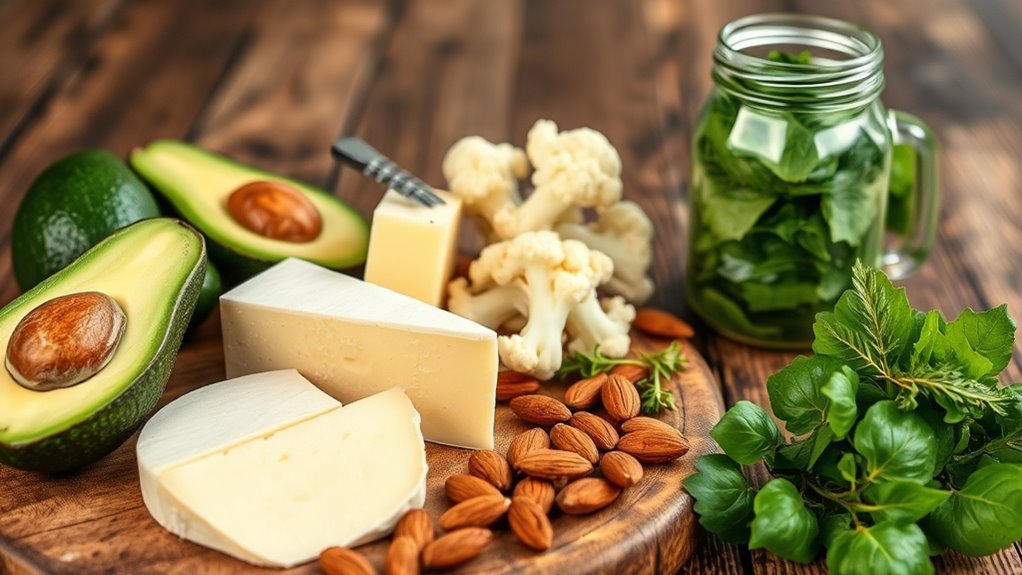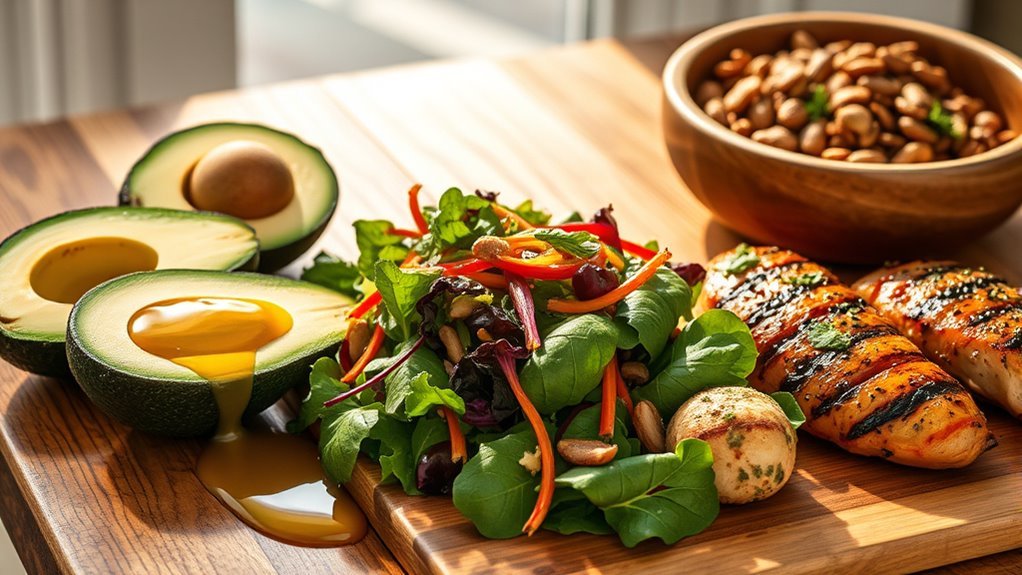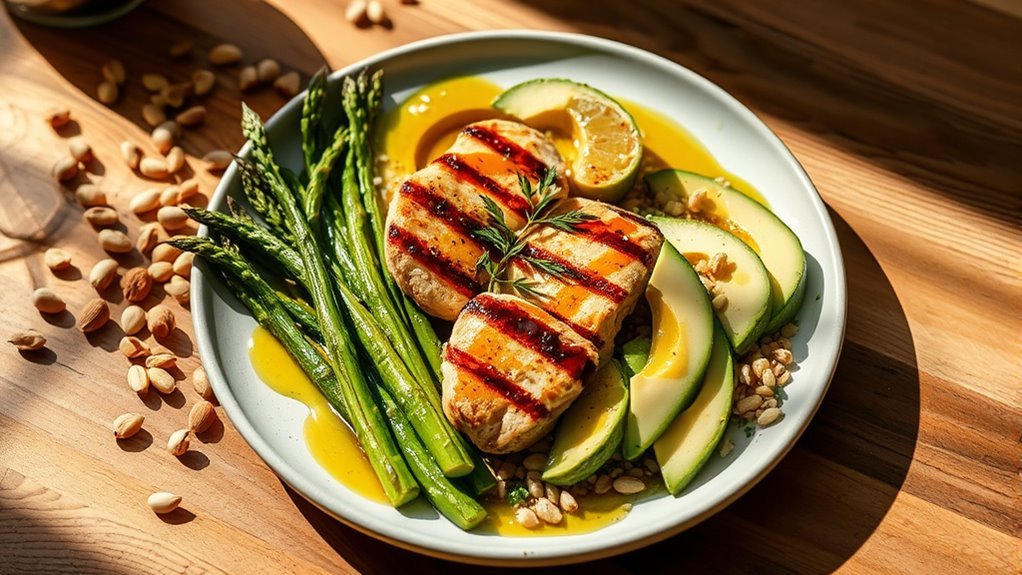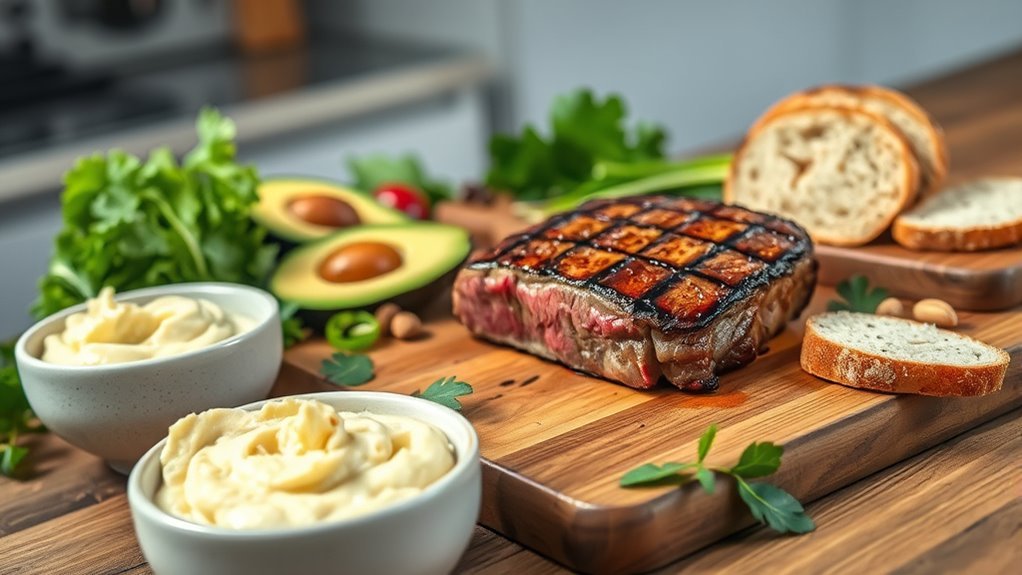The keto diet is inherently gluten-free since it excludes grains and sugars, which are the primary sources of gluten. You’ll naturally avoid gluten-containing foods like bread, pasta, and certain snacks while focusing on high fats and low carbohydrates. This restriction can benefit individuals with gluten sensitivity or celiac disease. By choosing keto-friendly alternatives such as almond flour and coconut flour, you can maintain your diet without the complication of gluten. There’s more to explore about managing this lifestyle effectively.
Understanding Gluten and Its Sources

Gluten, a protein found in certain grains, plays a significant role in the diets of many, yet it can pose health issues for some individuals. If you experience gluten sensitivity, you might notice symptoms like bloating, fatigue, or digestive discomfort after consuming gluten-containing foods. Understanding gluten digestion is essential for those affected. Wheat, barley, and rye are the primary sources of gluten, often lurking in bread, pasta, and many processed foods. For individuals with celiac disease, even trace amounts can trigger serious reactions. Thankfully, there are numerous gluten-free alternatives available, from quinoa to almond flour, enabling you to enjoy a diverse diet. By being mindful of your food choices, you can maintain your well-being without sacrificing flavor or freedom.
The Basics of the Keto Diet

The keto diet focuses on a specific macronutrient composition, typically consisting of high fats, moderate proteins, and very low carbohydrates. To succeed on this diet, you’ll need to restrict certain food groups, particularly those high in carbs, like grains and sugars. Understanding these basics is essential for anyone looking to explore the keto lifestyle effectively. This approach encourages the body to enter ketosis, where it shifts from burning carbohydrates to fats as its primary energy source.
Macronutrient Composition
While many diets focus on calorie counting, the ketogenic diet emphasizes a specific macronutrient composition that prioritizes fats over carbohydrates. Achieving the right macronutrient balance is essential for success. Here’s what you typically aim for:
- Fats: 70-75% of your daily intake
- Proteins: 20-25% of your daily intake
- Carbohydrates: 5-10% of your daily intake
- Nutrient Timing: Consuming fats and proteins at strategic times can enhance your results.
This composition helps your body enter ketosis, where it burns fat for fuel. By understanding these ratios, you gain the freedom to enjoy diverse food choices while maintaining energy levels and promoting overall well-being. Incorporating healthy fats into your meals is crucial for sustaining energy and health on this diet. Embrace the journey to find what works best for you!
Food Restrictions Overview
When steering through the ketogenic diet, understanding food restrictions is vital for maintaining ketosis and achieving your health goals. The primary focus is on low-carb foods, which means you’ll need to avoid grains, sugars, and starchy vegetables. If you have gluten intolerance, this diet can be beneficial, as it naturally excludes gluten-containing grains like wheat and barley. However, be mindful of hidden gluten in processed foods. You’ll want to emphasize healthy fats, lean proteins, and non-starchy vegetables, catering to your dietary preferences. Remember, while the keto diet offers freedom from certain foods, it’s important to make informed choices to guarantee you’re nourishing your body appropriately. Additionally, balancing macronutrient intake is crucial to maintain ketosis and ensure optimal energy levels. Feel empowered to explore delicious, keto-friendly options that fit your lifestyle!
How Gluten Fits Into a Keto Lifestyle

When you’re following a keto lifestyle, understanding the sources of gluten in common foods is essential for maintaining your carb limits. Many traditional staples, like bread and pasta, contain gluten, but there are plenty of keto-friendly alternatives that can help you avoid it without sacrificing flavor. By exploring these options, you can enjoy a varied diet while staying compliant with your keto goals.
Gluten Sources in Foods
Understanding gluten sources in foods is essential for anyone steering through a keto lifestyle, especially since many traditional keto-friendly foods can still harbor gluten. If you have gluten sensitivity, being aware of these sources can empower your journey toward health and freedom. Here are some common gluten sources to watch out for:
- Wheat-based products: Bread, pasta, and cereals often contain gluten.
- Processed foods: Many sauces, dressings, and snacks may have hidden gluten.
- Barley and rye: These grains are not keto-friendly and contain gluten.
- Cross-contamination: Even gluten-free foods can be affected if processed in shared facilities.
Incorporating low-carb alternatives can help you achieve your keto goals while avoiding gluten-related issues. Exploring gluten alternatives can help you maintain a keto lifestyle without sacrificing your health.
Keto-Friendly Alternatives Available
Maneuvering a keto lifestyle while avoiding gluten doesn’t have to be intimidating, thanks to a variety of keto-friendly alternatives. You can enjoy delicious keto snacks like cheese crisps, nut-based granola, or avocado-based dips that satisfy cravings without gluten. When it comes to baking, gluten-free flours such as almond flour, coconut flour, and flaxseed meal are excellent choices, allowing you to create low-carb treats without sacrificing flavor or texture. These alternatives not only fit seamlessly into your keto diet but also provide essential nutrients. Additionally, almond flour is low in carbohydrates, making it a preferred choice for those on a keto diet. Embracing these options empowers you to maintain a gluten-free lifestyle while enjoying the freedom and flexibility of keto. With some creativity, you can thrive on your keto journey without feeling restricted.
Common Gluten-Containing Foods to Avoid
Although the keto diet can be an excellent choice for those looking to reduce carbohydrate intake, it’s essential to be aware of common gluten-containing foods that can derail your efforts. Avoiding these foods will help you sidestep gluten sensitivity symptoms and support your journey to wellness. Here are four items to steer clear of:
Be mindful of gluten-containing foods while on the keto diet to ensure a successful and healthy journey.
- Wheat Products: Bread, pasta, and pastries are loaded with gluten.
- Barley: Often found in soups and beers, it’s a hidden source of gluten.
- Rye: Commonly used in bread and cereals, it’s best to skip.
- Certain Sauces: Soy sauce and some dressings may contain gluten.
Instead, focus on gluten free grains like quinoa and rice to stay on track with your keto goals.
Keto-Friendly Alternatives to Gluten Products
When you’re following a keto diet and aiming to avoid gluten, finding suitable alternatives can make all the difference in maintaining both your health and enjoyment of meals. Here are some keto-friendly options to evaluate:
| Gluten Product | Keto Alternative | Enjoyment Factor |
|---|---|---|
| Wheat flour | Almond flour | Perfect for baking |
| Bread | Lettuce wraps | Fresh and crunchy |
| Pasta | Zucchini noodles | Satisfies cravings |
| Crackers | Cheese crisps | Savory and satisfying |
These alternatives not only cater to your keto needs but also allow for creative gluten-free baking and delicious keto snacks. Embrace these options to keep your meals exciting and fulfilling while enjoying the freedom of a gluten-free lifestyle! Additionally, understanding the importance of low-carb vegetables can enhance your meal variety and nutritional intake.
Health Benefits of a Gluten-Free Keto Diet
Embracing a gluten-free keto diet can yield several health benefits, particularly for those with gluten sensitivities or celiac disease. By choosing this dietary path, you can experience:
Embracing a gluten-free keto diet offers numerous health benefits, especially for those with gluten sensitivities or celiac disease.
- Reduced Inflammation: Many find that eliminating gluten helps lessen inflammation, leading to improved joint health.
- Enhanced Digestion: A gluten-free keto diet often promotes better digestive health, minimizing bloating and discomfort.
- Increased Energy Levels: With a focus on healthy fats and low carbs, you’ll likely notice a boost in your overall energy.
- Weight Management: This combination can help with weight loss and maintaining a healthy weight, supporting your freedom to feel your best. Moreover, incorporating whole, nutrient-dense foods into your meals can further enhance health outcomes.
Tips for Following a Gluten-Free Keto Diet
Successfully managing a gluten-free keto diet requires careful planning and ingredient selection to guarantee you meet your nutritional goals while avoiding gluten. Start with meal planning by focusing on whole, unprocessed foods like meats, fish, eggs, and low-carb vegetables. Make sure to read labels carefully; some products may contain hidden gluten. For snack ideas, consider nuts, seeds, cheese, or homemade keto fat bombs, which can keep you satisfied without compromising your diet. Experiment with gluten-free flours like almond or coconut to create low-carb baked goods. Staying organized with a shopping list will help you avoid gluten-containing foods and keep you on track. With dedication and creativity, you can enjoy delicious meals while sticking to your gluten-free keto lifestyle.
Real-Life Success Stories: Gluten-Free Keto Journeys
While maneuvering through the complexities of a gluten-free keto diet can be challenging, many individuals have turned these obstacles into inspiring success stories. You can find motivation in their journeys, marked by determination and creativity. Here are some highlights that may resonate with you:
- Creative keto meal prepping helped Sarah lose 30 pounds while managing her gluten intolerance.
- Innovative gluten-free snacks like almond flour crackers kept Mark satisfied during his weight loss journey.
- Community support from online forums provided Emma with invaluable tips and recipes.
- Personal empowerment transformed John’s approach to food, making him feel in control of his health. Additionally, incorporating healthy fats into their meals enabled many to maintain energy levels throughout their journeys.
These stories show that with the right mindset and resources, you can embrace freedom on your gluten-free keto path.
Frequently Asked Questions
Can I Eat Gluten-Free Grains on a Keto Diet?
You can include some gluten-free grains on a keto diet, but you’ll need to be cautious about their carb content. Keto grain options like almond flour and coconut flour are excellent alternatives that keep your carb intake low. Other gluten-free alternatives, such as chia seeds and flaxseeds, can also fit into your keto plan. Just remember to track your macros to maintain ketosis while enjoying these alternatives!
Are All Keto Snacks Gluten-Free?
Not all keto snacks are gluten-free. While many keto snack options, like nuts and cheese, naturally don’t contain gluten, others might. It’s essential to check labels, as some brands may include gluten-containing ingredients or be processed in facilities with gluten. Look for gluten-free brands that cater specifically to keto diets, ensuring you enjoy your snacks without compromising your dietary needs. Always read ingredient lists to make informed choices and maintain your health goals.
How to Read Labels for Gluten on Keto Products?
When you’re label reading, look for gluten detection with diligence. Scan for ingredients like wheat, barley, or rye, which signal gluten presence. Check for “gluten-free” certifications; they’re your golden guarantee. Be mindful of hidden sources like sauces or processed products, too. Don’t forget about cross-contamination warnings, which can sneak in gluten during production. Your health’s worth it, so embrace awareness and enjoy the freedom of truly keto-friendly, gluten-free choices!
Does Gluten-Free Mean Low-Carb on a Keto Diet?
Gluten-free doesn’t automatically mean low-carb, especially on a keto diet. While gluten-free foods can offer benefits like improved digestion for those with sensitivities, many gluten-free products are still high in carbs. It’s crucial to look beyond labels and understand that low-carb misconceptions can lead you astray. Focus on whole foods like meats, vegetables, and healthy fats to achieve your keto goals without the gluten, and stay mindful of your carbohydrate intake.
Can I Use Gluten-Free Flour in Keto Recipes?
Yes, you can use gluten-free flour in keto recipes, but it’s essential to choose wisely. While traditional flours are high in carbs, gluten-free substitutions like almond flour or coconut flour are popular keto flour alternatives. These options maintain a low-carb profile and provide the freedom to enjoy baked goods without compromising your diet. Just remember to adjust your recipes, as these flours behave differently than regular flour. Happy baking!


